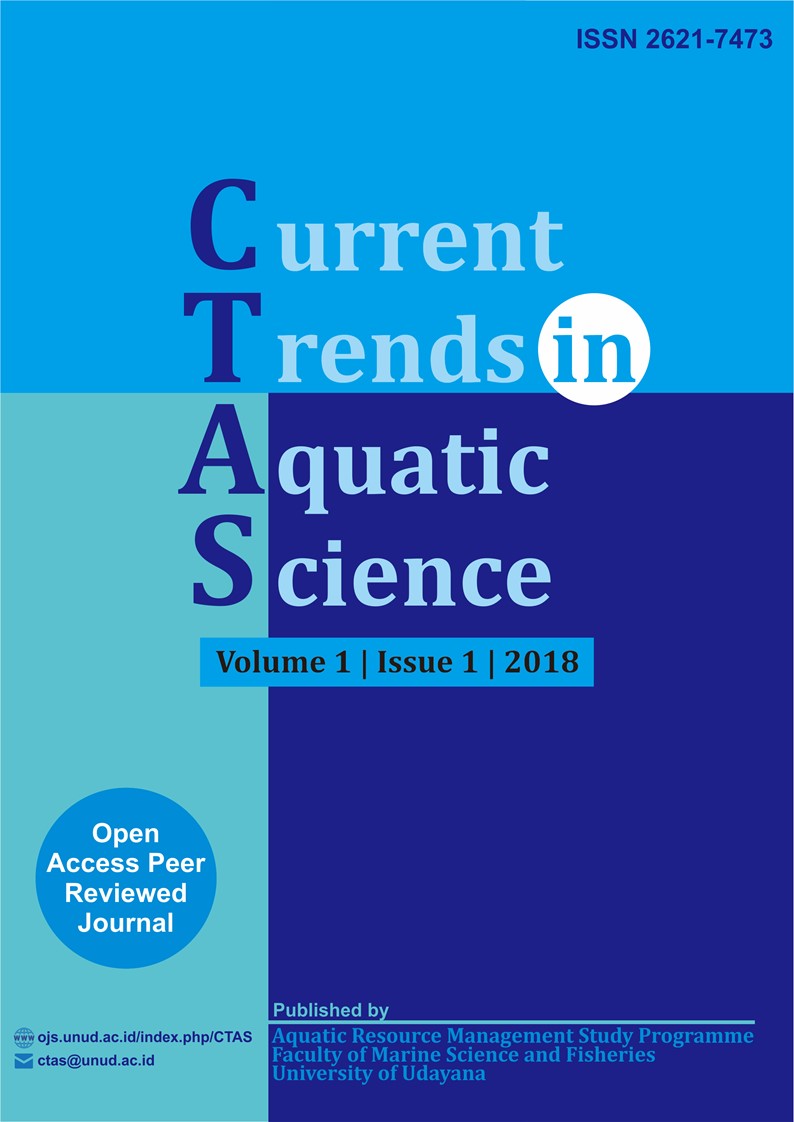Uji Tantang Bakteri Vibrio harveyi Pada Pasca Larva Udang Vaname (Litopenaeus vannamei)
Abstract
This research aims to determine the survival of Litopenaeus vannamei post larvae when challenged with various density of pathogenic Vibrio harveyi. The L. vannamei post larvae used in this study was obtained from Vannamei Broodstock Center BPIUUK, Karangasem Bali. This research was conducted for two months, from April to May 2018 in fishery laboratory, Faculty of Marine Science and Fisheries, Udayana University by using complete randomized experimental design with four different V. harveyi density and three times repetitions. The study showed that the higher density of pathogenic V. harveyi resulted on the lower survival of L. vannamei post larvae. The highest density of V. harveyi 107 CFU/mL in treatment D resulted on 53±5.77% post larvae survival, while treatment A as control without addition of V. harveyi was still has survival of 100±0.00% at the end of experiment. The density 105 CFU/mL of V. harveyi (Treatment B) seems able to be tolerated by L. vannamei post larvae since the shrimp was still have high survival at this V. harveyi density. Further both V. harveyi density of 106 CFU/mL and 107 CFU/mL were not able to tolerated by the shrimp post larvae and lead to the high shrimp mortality. Although affected on shrimp survival, addition of V. harveyi have no significant effect to the weight of shrimp post larvae between treatments.
Downloads
References
Bakhtiar. 2004. Efektifitas Penggunaan Antibiotik untuk Mengontrol Penyakit Bakteri Vibrio harveyi pada Pasca Larva Udang Windu Penaeus monodon Fabricius. [Tesis]. Program Pascasarjana. Universitas Hasanuddin. Makassar.
Bibiana, W.L. 1994. Analisis mikroba di laboratorium. PT Raja Grafindo Persada. Jakarta. vii + 168 hlm.
Brunt J, Austin B. 2005. Use Of A Probiotic To Control Lactococcosis And Streptococcosis In Rainbow Trout Oncorhynchus Mykiss (Walbaum). Journal of Fish Diseases 28:693−701.
Chau, N.T.T., N.X. Hieu., L.T.N. Thuan., M. Matsumoto., I. Miyajima. 2011. Identifcation and Characterization of Actinomyces Antagonistic to Pathogenic Vibrio Spp. Isolated From Shrimp Culture Pond Sediments in Thua Thien Hue-Viet Nam. J. Fac. Agr. Kyushu Univ. 56(1): 15-22.
Donnenberg MS. 2000. Pathogenic strategies of enteric bacteria. Nature 406: 768–774.
Effendi, R. 1997. Biologi Perikanan. Yayasan Pustaka Nusatama: Yogyakarta. 163 hal.
Feliatra, Nugroho, F., Sazali, T. dan Yuslina, S. 2011. Molecular Characteristics of Vibrio sp Causing Giant Tiger
Prawn (Penaeus monodon) Disease By DNA 16s Sequencing. Agricultural Technology: 7 No 3 (679-694).
Feliatra, Zainuri, Dessy Y. 2014. Pathogenitas Bakteri Vibrio sp Terhadap Udang Windu (Penaeus monodon). Jurnal Sungkai, Vol. 2 (1): 23-36.
Hadioetomo, R.S. 1993. Mikrobiologi Dasar Dalam Praktek: Teknik Dan Prosedur Dasar Laboratorium. Gramedia Pustaka Utama. Jakarta.
Hoa, T.T., Hoang, D.T., & Phuong, N.T. 2006. Study On Disease In Giant Freshwater Prawns (Macrobrachium rosenbergii): A Review. Departement of Fisheries Biology, College of Aquaculture and Fisheries, Can Tho University, p. 1-7.
Holt, J.G and N.R Krieg. 1984. Bergeys’s Manual of Sistemic Bacteriolgy, Vol.1. The Williams and Wilkins Co. Baltimore.
Lavilla-Pitotogo, C.R., Albright, L.J., Paner, M.G., and Sunaz, NA. 1990. Studies on the Source of Luminescent Vibrio harveyi in Penaeus monodon Hatcheries. Pp.157-164.
Mariyono, A. Wahyudi, & Sutomo. 2002. Teknik Penanggulangan Penyakit Udang Menyala Melalui Pengendalian Populasi Bakteri Di Laboratorium. Buletin Teknik Pertanian Vol. 7(1) : 25-27.
Mariyono, Wahyudi, A., Sutomo. 2006. Teknik Penanggulangan Penyakit Udang Menyala Melalui Pengendalian Populasi Bakteri Di Laboratorium. Buletin Teknik Pertanian Vol 7 (1): 25-27.
Nakayama T, Suda S, Kawachi M, Inouye I. (2007). Phylogeny and ultrastructure of Nephroselmis and Pseudoscourfieldia (Chlorophyta), including the description of Nephroselmis anterostigmatica sp. Nov., and a proposal for the Nephroselmidales ord. nov. Phycologia 46:680-697.
Nur, A. 2011. Manajemen Pemeliharaan Udang Vannamei. Direktorat Jenderal Perikanan Budidaya. Balai Besar Pengembangan Budidaya Air Payau Jepara. OIE, 2007. IQ2000TM IMNV Detection.
Pelczar, M.J. dan E.C.S. Chan. 2002. Dasar-dasar Mikrobiologi Jilid ke-1. Jakarta. UI-Press.
Prabowo, S.A. 2003. Alih bahasa dari Asian Aquaculture Magazine. Buletin Biru Laut. Edisi I Maret 2003. Unit Data & Informasi Departemen Laboratorium & Monitoring Research and Development PT. Biru Laut Khatulistiwa. Lampung.
Praditia, F.P. 2009. Pengaruh Pemberian Bakteri Probiotik Melalui Pakan Terhadap Pertumbuhan dan Kelangsungan Hidup Udang Windu Penaeus monodon. [Skripsi]. Departemen Budidaya Perairan, Fakultas Perikanan dan Ilmu Kelautan, Institut Pertanian Bogor.
Sugama, K., H. Novita and I. Koesharyani. 2006. Production Performance, Diseases, SPF-Breeding and Risk Issues Concerning White Shrimp, Penaeus vannamei, Introduction Into Indonesia. Indonesian Aquaculture Journal, 1 (1), 2006.


